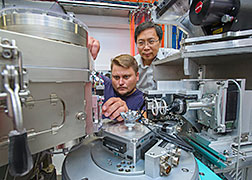- Number 449 |
- October 5, 2015
Exposing the flexible boundary between phases in supercritical fluids

Dima Bolmatov and NSLS-II IXS beamline
group leader Yong Cai making adjustments
at the beamline experimental end station.
Imagine a gas giant planet like Jupiter. Where does the surface begin and the atmosphere end? Questions like these can be answered by understanding the boundaries between phases of matter, which we sometimes think of as delineated by strong boundaries.
But expose certain gases to enough pressure and heat, and they will enter a hinterland between the phases where they can have the properties of both a gas and a liquid at the same time. This extraordinary behavior of ordinary liquids in the “supercritical” phase is exploited for use in many technologies, for example in decaffeinating coffee, producing pharmaceuticals and cosmetics, and even dry-cleaning and nuclear waste cleanup.
Dima Bolmatov, a physicist at the National Synchrotron Light Source II (NSLS-II) at DOE's Brookhaven Lab, recently led a study to better understand the nature of the boundary between phases and the behavior of supercritical fluids. His team used high-energy x-rays at the Advanced Photon Source at Argonne National Lab to examine the atomic structures of these materials at different temperatures and pressures. The tests resulted in a new understanding of the boundaries between phases. Instead of an abrupt change, they found that supercritical fluids transform between phases in a smooth, continuous manner.
Knowledge about this boundary will help scientists fine-tune supercritical fluids using temperature or pressure in order to use them more efficiently and better predict the behavior of the fluid.
Bolmatov’s work will continue at the Inelastic X-ray Scattering (IXS) beamline at NSLS-II, which will offer the best energy resolution in the world for measurements of atomic and molecular dynamics at the nanometer length scale. Now in the commissioning phase, the IXS beamline should be operational by the end of 2015, when it will begin hosting scientific users.
Full story: https://www.bnl.gov/newsroom/news.php?a=25872
[Chelsea Whyte, 631.344.8671,
cwhyte@bnl.gov]
